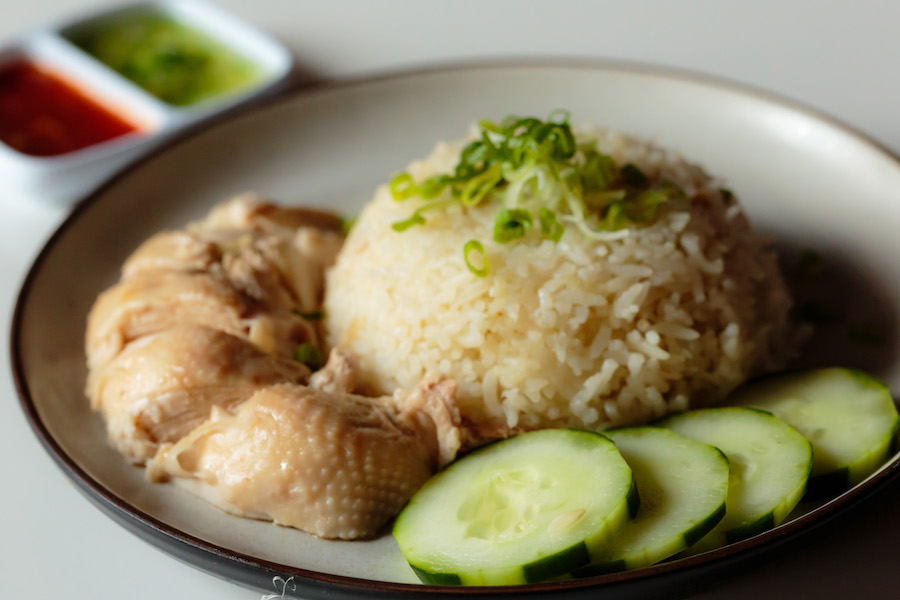I have a few qualms about Crazy Rich Asians (its representation of Singapore's minorities, Awkwafina's blaccent) but the one scene I truly adore is the montage of the hawker center, where the cast gathers to devour satay and laksa. It signaled home for me, and I was proud to see my culinary heritage given some glamorous Hollywood screen time.
I know many others also consider it one of the film's most memorable moments; it has even sent some Chicagoans in search of Singaporean dishes in this city. Some have called up Rickshaw Republic (2312 N. Lincoln Ave.), known for its Indonesian food, to ask if it serves grub from the island city-state. It doesn't — but the calls got manager Oscar Setiawan thinking. Two weeks ago, Rickshaw Republic launched a Crazy Rich Asians-inspired prix-fixe meal inspired by the hawker center scene, as Eater first reported.
"I guess at that point Singapore was more famous, and people knew it's right next to Indonesia, so they thought Indonesia equals Singapore," Setiawan says. "So we thought it would be fun to introduce hawker food and the hawker experience."
For $49, patrons receive seven courses, including Hokkien prawn mee (a spicy noodle dish) and fragrant Hainanese chicken rice. The special menu is offered only on Friday evenings and Saturday, and it will change slightly every month. Setiawan says it will be offered indefinitely and hopes he will be able to lower its cost as demand increases. Reservations, which you can get online, are being made quickly.

Rickshaw Republic is family-owned, and the Setiawans, who are Chinese-Indonesian, were all born in Indonesia. They have a family house in Singapore and travel there often, so hawker center fare is very familiar to them. In fact, they often cook Singaporean dishes at home.
Given the diversity of its population, Singaporean cuisine is a result of a hodgepodge of influences from China, Malaysia, India, and Indonesia. Rickshaw Republic wants to celebrate the uniqueness of this culture.
"Chicago is a big foodie place, but there’s really a lack in diversity of Southeast Asian cuisine," Setiawan says. "We're an ambassador of Indonesia, but we're being an unofficial one of Singapore now. We want to be a bridge that connects people through food discovery."
Setiawan previewed some of the dishes for us below.
Laksa
"When you talk about laksa in Asia, it's like talking about chicken noodle soup in America. Every one is different. Last November, when I visited Singapore, I tried several types from different food stalls. Having different seafood ingredients is important, so our coconut milk broth has fresh shrimp heads, clams, squid, fish cake, prawns, and a boiled egg. We also make it with two types of noodles: egg and rice noodles, because the more popular places in hawker centers use both."
Carrot cake
"It's not carrot, and it's not a cake, but a translation of the [Hokkien] word chai tow kway. We use daikon rice cake and stir-fry it in a wok with scrambled eggs and add green onion. Instead of a black soy — one popular version in Singapore — we use a light soy. The mix of ingredients makes this unique to Singapore and Malaysia; there's a subtle difference from the carrot cake you can get at a dim sum restaurant."
Hainanese chicken rice
"The chicken is boiled with skin on, and served with fresh cut ginger oil and homemade chili sauce. One thing my mom pointed out to me is that when you eat this dish in Singapore, the white meat is served skin-on but without bones, while the dark meat has bones on. That's different from a typical Chinese restaurant, where a chicken would be all bones. The rice is slow-cooked in a chicken stock made with the breast bones."
Rojak
"We use fresh, cut fruit — jicama, young mango, strawberry, pineapple — and cucumbers, which we mix with liquid Indonesian palm sugar. We add crusty nuts and chili to give it a kick, so it's a surprising, spicy dessert. I know you can technically eat rojak anytime, but we course out our dishes to avoid overwhelming people. That's another difference between us and a hawker stall, where everything would come out on the table at once."



